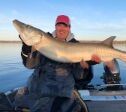- 0



By SkunkedAgain · Posted



By CigarGuy · Posted
.thumb.jpg.5c1a86e9339e49e53f5bfefed2220054.jpg)
By LakeofthewoodsMN · Posted

By Brianf. · Posted
By using this site, you agree to our Terms of Use and Privacy Policy. We have placed cookies on your device to help make this website better. You can adjust your cookie settings, otherwise we'll assume you're okay to continue.

Question
Rockin Rod
Looking at a Stealth or the Minnkota DC alternator charger for my trolling motor batteries for when I go on long excursions up to LOW with no power. Does anyone have any experience with either?
Link to comment
Share on other sites
Top Posters For This Question
29
14
8
4
Popular Days
Mar 31
26
Apr 4
23
Mar 30
6
Jun 26
5
Top Posters For This Question
CaptainMusky 29 posts
CAMAN 14 posts
Rockin Rod 8 posts
pheasantpete 4 posts
Popular Days
Mar 31 2014
26 posts
Apr 4 2014
23 posts
Mar 30 2014
6 posts
Jun 26 2014
5 posts
75 answers to this question
Recommended Posts
Join the conversation
You can post now and register later. If you have an account, sign in now to post with your account.
Note: Your post will require moderator approval before it will be visible.